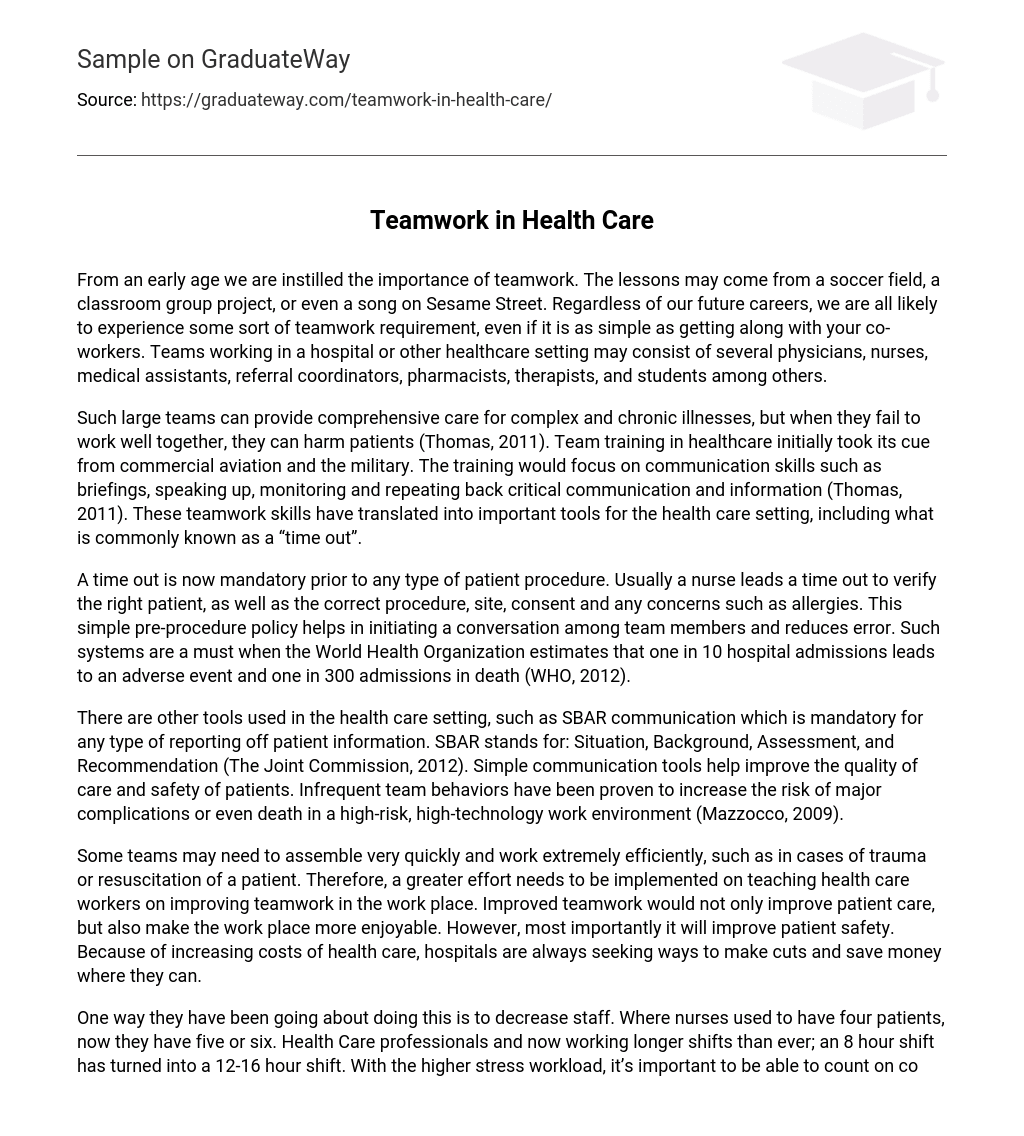From an early age, we are educated about the importance of collaboration, which can be acquired through various activities such as participating in soccer matches, collaborating on group projects at school, or even by watching a song on Sesame Street. Irrespective of our future careers, there will inevitably be instances where teamwork is vital, whether it involves simply working harmoniously with colleagues or engaging in more complex situations. In medical settings like hospitals and healthcare facilities, teams typically consist of doctors, nurses, medical assistants, referral coordinators, pharmacists, therapists, and students.
Large healthcare teams have the potential to offer extensive care for intricate and persistent diseases. However, if these teams do not function effectively together, they can cause harm to patients (Thomas, 2011). The training for teamwork in healthcare was initially inspired by the practices in commercial aviation and the military. This training emphasized communication skills such as briefings, speaking up, monitoring, and repeating important communication and information (Thomas, 2011). These skills have been adopted as crucial tools in the healthcare setting, such as the widely recognized “time out”.
The implementation of a time out is necessary before every patient procedure. Typically, a nurse is responsible for conducting the time out, which includes confirming the correct patient, procedure, site, consent, and addressing any concerns like allergies. This straightforward pre-procedure policy encourages team communication and minimizes mistakes. It is crucial to have such systems in place considering the World Health Organization’s statistics indicating that one out of every ten hospital admissions results in an adverse event and one out of every 300 admissions results in death (WHO, 2012).
SBAR communication is a mandatory tool used in the health care setting for reporting off patient information. SBAR stands for: Situation, Background, Assessment, and Recommendation (The Joint Commission, 2012). The use of simple communication tools improves the quality of care and patient safety. Research has shown that infrequent team behaviors in a high-risk, high-technology work environment increase the risk of major complications or even death (Mazzocco, 2009).
Efforts should be focused on teaching healthcare workers to improve teamwork in the workplace, especially for teams that need to quickly assemble and work efficiently, like in trauma or patient resuscitation cases. Enhancing teamwork not only enhances patient care but also fosters a more enjoyable work environment. Most importantly, it ensures patient safety. Given the rising costs of healthcare, hospitals constantly seek opportunities to make cost-saving measures.
One strategy for achieving this goal is reducing staff numbers, resulting in an increased patient load for nurses. Previously, nurses would care for four patients, but now they are responsible for five or six. Furthermore, healthcare professionals are now working longer shifts than before, with 8-hour shifts extending to 12-16 hours. With such a demanding workload, the ability to rely on co-workers becomes crucial. Despite recognizing the significance of teamwork, the issue lies in the demanding nature of healthcare work, where no single profession can provide comprehensive care alone.
According to Leggat (2007), there is a lack of formal training in teamwork skill development in undergraduate or postgraduate health professional education programs. This implies that most team work skills are acquired through on-the-job learning. However, it is crucial to be better prepared for effective interdisciplinary teamwork as patient outcomes depend on it. This preparation should begin by reaching an agreement on the qualities that constitute a good team. It is also important to note that the competencies for effective teamwork are perceived differently between management and clinical teams, and there are also differences in perceptions of teamwork between male and female health care managers.
Teamwork can be disrupted by various factors such as different management styles, status differences, poor communication, and competitive demands on different departments. In my personal experience in nursing, I have witnessed both the best and worst examples of teamwork. On a neuro critical care floor, while assisting a nurse in turning and changing a patient, we would consistently trigger an alarm each time. However, each time the alarm went off, there was always a voice on the other side of the curtain offering assistance.
When the alarm sounds, the nurse is comforted and guided by a helpful voice, resulting in improved outcomes and patient safety. Unfortunately, there have been cases where nurses are refused assistance when requested, often with the response “that’s not my job.” It is astonishing to witness a nurse providing dedicated care to patients in critical conditions, such as performing resuscitation or arranging transfers to intensive care units. However, it is concerning that no one checks on the patients of these nurses while they are absent, including the charge nurse.
It is evident that this work environment does not promote positivity or safety. By working together with colleagues in the healthcare industry, their workload can be reduced and burnout can be prevented. As healthcare costs continue to rise in the US, efficiency becomes crucial and mistakes are unacceptable. The significance of teamwork cannot simply be talked about; it must be taught through education. Each team member should comprehend their specific duties, obligations, and anticipated outcomes in various situations.
It is essential to train team members on effectively working with individuals from different backgrounds and cultures. Collaboration among all members of a patient’s multidisciplinary health team, known as collaborative care, is crucial for delivering comprehensive and optimum healthcare. Ineffective teamwork can lead to chaos and communication difficulties, causing medical mistakes and negatively impacting patient outcomes.
References
Leggat, S. (2007). Effective healthcare teams require effective team members: defining teamwork competencies. BMC Health Services Research, 7(17), doi: 10.1186/1472-6963-7-17.
Mazzocco, K., et al. (2009). Surgical team behaviors and patient outcomes. The American Journal of Surgery, 197, 678-685, doi: 10.1016/j.amjsurg.2008.03.002.
The Joint Commission. (2012). http://www.jointcommission.org/
Thomas, E. (2011). Improving teamwork in healthcare: current approaches and the path forward. BMJ Quality & Safety, 20, 647-650, doi: 10.1136/bmjqs-2011-000117.
World Health Organization.(2012).http://www.whoint/en/





